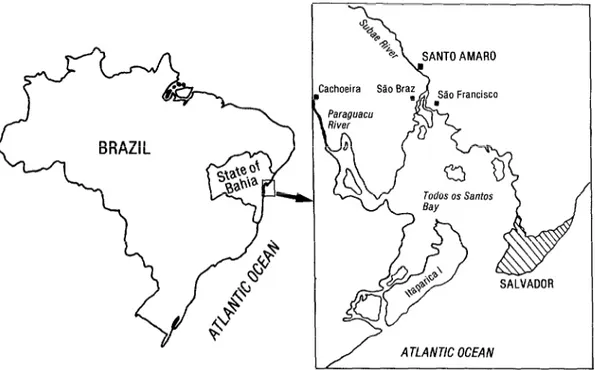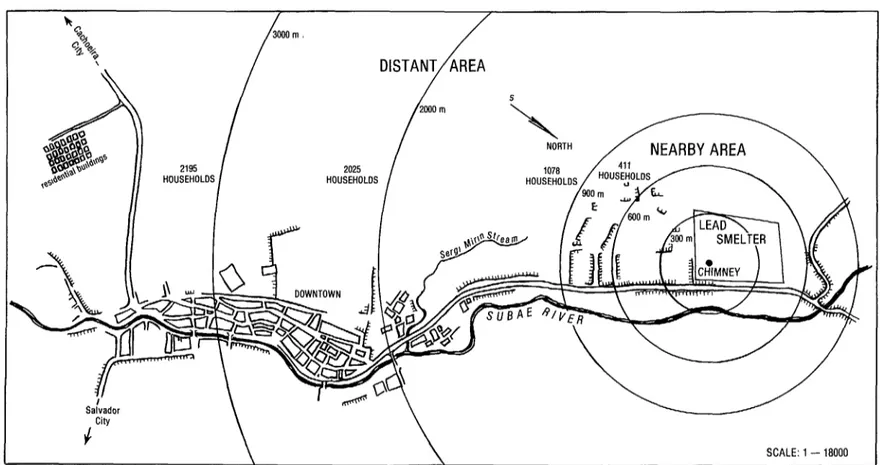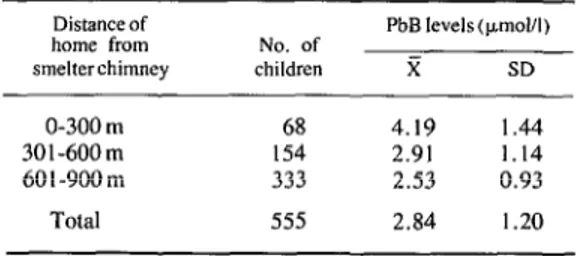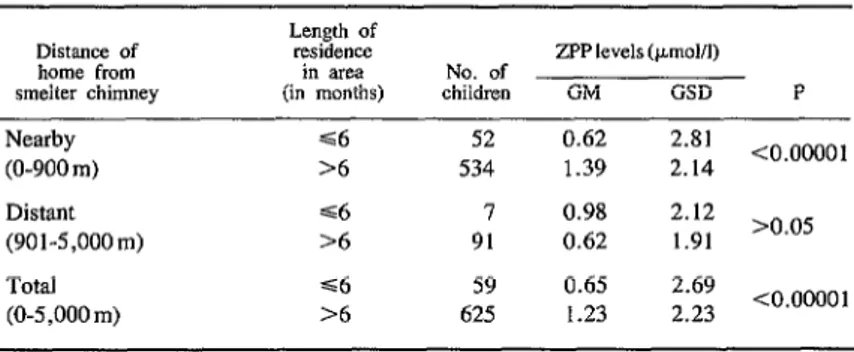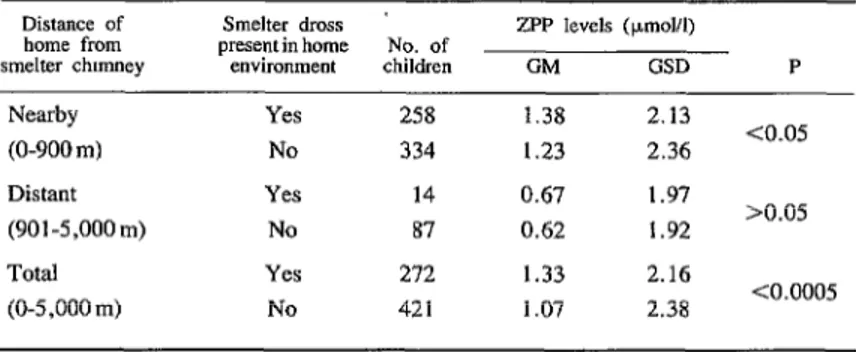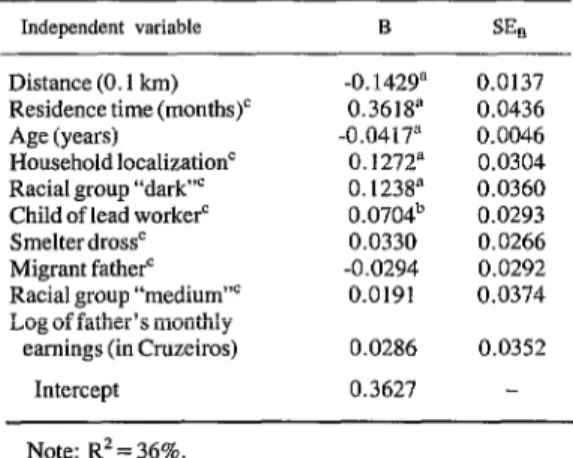LEAD POISONING
AMONG CHILDREN
FROM SANTO AMARO,
BRAZIL’
Fernando M. Carvalho,2 Annibal M. Silvany-Neto,2 Tania M. Tavares,3
Maria Engracia C. Lima,4 and Harry A. Waldron5
A survey designed to detect lead poisoning was carried out among 693 children living near a lead smelter in Santo Amaro. Brazil. Very high levels of zinc protoporphyrin and lead were detected in the chil- dren’s blood, revealing serious lead poisoning and dangerous levels of environmental contamination.
Introduction
Santo Amaro is a city in the state of Bahia in Northeast Brazil; according to the 1980 National Census (1) Santo Amaro then had a population of 29,627 inhabitants. For hundreds of years, sugar cane has been the area’s main cash crop, but the city’s strategic location in the inner part of Todos OS Santos Bay (Figure 1) has also fa- vored a flourishing maritime trade. In recent decades, the rapid industrialization of nearby areas and the extensive use of highways for transportation of goods has produced a negative impact upon the economic life of the city. (Fish- ing, once an important economic subsistence activity, has been declining, for example.) These circumstances have contributed to making a large number of people unemployed, although local conditions have also attracted some indus- tries to the area, mainly because of cheap and abundant labor.
Over the past three decades, living conditions in northeastern Bahia’s rural areas have been gradually deteriorating. Consequently, large
‘This article will also be published in Portuguese in the Boletin de la Oficina Sanitaria Panamericana, 1986.
‘Lecturer, Department of Preventive Medicine, Federal University of Bahia, Brazil.
‘Senior Lecturer, Chemistry Institute, Federal University of Bahia, Brazil.
4Physician, Ministry of Labor (FUNDACENTRO), Sal- vador, Brazil.
‘Senior Lecturer, Institute of Occupational Health, Lon- don School of Hygiene and Tropical Medicine, England.
numbers of rural people have migrated to the cities; and the industries established in Santo Amaro, including a lead smelter, have served as magnets for immigrants seeking work. Consequently, newly arrived families have tended to occupy areas near such industries that have also tended to be the worst residential areas in the city. As a result of this process, a large population current- ly lives around the Santo Amaro lead smelter, most of this population consisting of the mem- bers and immediate families of the smelter’s own work force.
This primary lead smelter, a subsidiary of the multinational company Penarroya, has been operating on the outskirts of Santo Amaro since 1960. The smelter has employed about 260 workers and has produced about 32,000 tons of lead bars per year (2). Since its inception, how- ever, the smelter has given rise to complaints from local residents concerning the death of cat- tle, horses, and birds as well as loss of garden crops. It is known that at least 250 tons of cad- mium have been dumped directly into the Subae River, which crosses the city, and that another 150 tons have been released to the air. The total lead burden is difficult to estimate, but the con- tamination of sediments and fauna by heavy metals has been reviewed by Souza et al. (3). The toxic effects of environmental lead and cadmium on the health of the local inhabitants have been described elsewhere (4, 5, 6, 7). The aim of the study reported here was to determine the preval- ence of lead poisoning among the children in
166 PAHOBULLETIN l vol. 19, no. 2, I985
Figure 1. A map of Brazil showing the state of Bahia and the location of Santo Amaro.
ATLANTICOCEAN
Santo Amaro and to describe the major risk fac- tors involved.
Materials and Methods
For purposes of this study, a prevalence sur- vey of lead poisoning among children one to nine years old who were living in the urban area of Santo Amaro was carried out in the third quarter of 1980. The city was divided into two survey zones, one zero to 900 meters from the smelter chimney (Figure 2) and the other more distant (901 to 5,000 meters from the chimney). Detailed city maps were provided by the local prefecture.
The zinc protoporphyrin (ZPP) concentration in the blood of 592 of the 648 children living in the nearby area was determined. In the distant area, a random sample, stratified by three sub- areas (at distances of 901-2,000 meters, 2,001- 3,000 meters, and 3,001-5,000 meters from the chimney) (8) was obtained. A pilot study car-
ried out among 29 children one to nine years old provided some basic information for the defini- tive sampling, during which samples were ob- tained from 101 children in 10 1 different house- holds, out of the distant area’s total of 5,298 households,
The adults responsible for each child were inter- viewed in the home by two physicians and two medical students. Mothers were asked for infor- mation about the child; fathers were asked about their monthly earnings and their occupational and migratory histories.
Figure 2. A map of Santo Amaro showing the “nearby” study area (within 900 meters of the smelter chimney), the “distant” study area (9014,000 meters from the smelter chimney), and the numbers of
households within 900, 2,000, 3,000, and 5,000 meters of the chimney.
Salvador
City \
.
i
168 PAHO BULLETIN l vol. 19, no. 2, 1985
of each household to the asphalt roads on which trucks transported lead ore was also noted. The children were classified into three racial groups based on skin color (IO), these being “light,” “medium,” and “dark.”
Blood was obtained by venipuncture from chil- dren in the area near the chimney, and by finger- prick and collection in capillary tubes from those in the distant area. The ZPP concentration in whole blood was determined with a hemato- fluorimeter manufactured by Buchler Instru- ments, using their instructions (I I). The lead in the blood samples (PbB) was analyzed by flame- less atomic absorption, using a modification of the method described by Femandez (12). Serum iron (FeS) and total iron-binding capacity (TIBC) were determined photocolorimetrically, using the Harleco method (13). The transferrin satura- tion (TS) index was calculated as follows:
FeS + TIBC X lOO=TS.
PbB and FeS determinations were made only for study children in the nearby area; the num- bers of analyses were 555 and 512, respectively. ZPP and PbB concentrations were expressed in “international system” (SI) units (14). (The fac- tor needed to convert ZPP p,mol/l to Fg/dl is 57.14, and that needed to convert PbB pmol/l to kg/d1 is 20.83.) A set of statistical computer programs developed by Nie et al. (1.5) was used for data analysis. The distributions of ZPP and of fathers’ earnings were very skewed, and were therefore logarithmically transformed. Mean ZPP levels were always expressed as the geometric mean (GM) and its standard deviation (GSD).
Results
Table 1 shows the mean (GM) levels of ZPP in terms of the distance from the child’s home to the smelter chimney. The geometric mean and the geometric standard deviation of the ZPP levels were 1.16 and 2.31 pmol/l, respectively, with the observed range of individual ZPP levels extending from 0.07 to 14.45 pmol/l. Levels greater than 1 .OO p,mol/l and 5.00 pmol/l were
found in 58.5% and 3.2% of the study children, respectively.
Like ZPP levels, the PbB levels observed in children from the nearby area showed a marked tendency to decrease with increasing distance from the smelter chimney (Table 2). Overall, the mean PbB level was 2.84 pmol/l, with a stan- dard deviation of 1.20; the actual values obtained ranged from 0.77 to 7.50 pmol/l. Seventy-five per cent of the study children tested were found to have PbB levels greater than 2.00 pmol/l. The simple regression coefficients between IogZPP and PbB and between IogZPP and the transferrin saturation index (TS) were r = 0.54 (P<O.OOOOl) and r = -0.13 (P<O.O05), respec- tively. The partial correlation coefficient be- tween 1ogZPP and PbB, controlling for the effect of TS, was 0.55; and that between IogZPP and TS, controlling for the effect of PbB, was -0.17.
Table 1. Zinc protoporphyrin (ZPP) levels found in 693 study children living at different distances from the
smelter chimney. The levels shown for each group are the geometric mean (GM) and the geometric
standard deviation (GSD).
Distance of home from smelterchlmney O-300 m 301-600 m 601-900m 901-2,OOOm 2,001-3,OOOm 3,001-5,OOOm Total
No of children 73 170 349 21 38 42 693
ZPP levels (pmolll)
GM GSD
2.83 1.85
1.47 2.41
1.03 2.02
0.93 1.86
0.74 1.84
0.45 1.74
1.16 2.31
Table 2. Blood lead (PbB) levels found in 555 study children living within 900 meters of the smelter chimney, by 300-meter intervals. The figures shown for each group are the arithmetic mean (%) and standard deviation (SD).
Distance of home from smelterchimney
No. of children
PbB levels (pm&l)
x SD
O-300 m 68 4.19 1.44
301-600m 154 2.91 1.14
60 I-900 m 333 2.53 0.93
Carvalho et al.
. LEAD POISONING IN SANTO AMARO, BRAZIL169
Photographs from Santo Amaro showing
(1) old filter material given away by the
smelter and used as carpets; (2) smelter
dross along a roadside, free for the taking;
and (3) the road referred to in the text that
was used by trucks transporting smelter ore.
Most homes in the latter picture are within
600 meters of the smelter chimney.
170 PAHO BULLETIN l vol. 19, no. 2, 1985
As Table 3 shows, children one and two years old had the highest mean ZPP levels. Also, the geometric mean ZPP levels of the study children who had migrant fathers (GM of 1.12 pmol/l with a GSD of -+ 2.32 kmol/l) was significantly lower (PCO.05) than that of the study children whose fathers had never left Santo Amaro (GM of 1.34 p,mol/l with a GSD of +2.24 Fmol/l). In addition, as Table 4 shows, children who had lived for six months or less in the area within 900 meters of the smelter chimney had a lower geo- metric mean ZPP than those who had lived there longer. This tendency was evident only among children in the “nearby” area rather than the “distant” area (see Figure 2).
Table 3. Zinc protoporpbyrin (ZPP) levels in the 693 study children, by age group.
Regarding racial groupings, the data in Table 5 indicate that the study children classified as being “dark” had higher mean ZPP levels than did the children classified as being “medium” or “light.” Also, children in both the “distant” and ‘ ‘nearby” areas whose fathers were lead workers were found to have significantly higher ZPP levels than children in the same area whose fathers pursued other types of work (Table 6). And children whose homes were situated along roads on which the smelter ore was transported were also found to have significantly higher ZPP levels (P<O.OOOOl) than other study children (Table 7). This last difference was evident mainly among children living in the “nearby” area. The presence of visible smelter dross in a child’s home environment was also associated with significantly higher mean ZPP levels when the sample was analyzed in total (P<O.O005) but not when it was analyzed by area (Table 8).
Children’s age No. of
(in years) children
ZPP levels (pmol/l)
GM GSD
1 70 1.90 2.26
2 100 1.48 2.07
3 95 1.17 2.19
4 78 0.96 2.30
5 71 1.04 2.22
6 68 1.15 2.20
7 74 1.16 2.08
8 63 0.78 2.39
9 74 1.01 2.53
Total 693 1.16 2.31
Table 5. Zinc protoporphyrin (ZPP) levels among the study children, by racial classification.
Racial
classification children No. of
ZPP levels (pm&l)
GM GSD
Light 105 0.95 2.24
Medium 211 1.03 2.23
Dark 373 1.32 2.33
Total 689 1.16 2.31
Table 4. Zinc protoporphyrin (ZPP) levels found in 625 of the study children grouped according to whether they had lived in their area of residence for more or less than six months, and whether their home was less than 900 meters or between 901 and
5,000 meters from the smelter chimney.
Distance of home from smelter chimney
Length of residence in area (in months)
ZPPlevels (pmolll) No. of
children GM GSD P
Nearby s6 52 0.62 2.81
(O-900 m) >6 534 1.39 2.14 <0.00001
Distant s6 7 0.98 2.12
(901-5,OOOm) >6 91 0.62 1.91 >0.05
Total s6 59 0.65 2.69
Carvalho et al. 0 LEAD POISONING IN SANTO AMARO, BRAZIL 171
Table 6. Zinc protoporphyrin (ZPP) levels among study children whose fathers were lead workers, as compared to those whose fathers were not.
Distance of home from smelter chimney
Nearby
(O-900 m) Distant (901-5,OOOm) Total (O-5,000 In)
Child of leadworker
Yes No Yes No Yes No
ZPP levels (pmol/I) No. of
children GM GSD P
130 1.71 2.12
457 1.19 2.28 <0.00001
3 1.76 1.26
96 0,60 1.89 <0.005
133 1.71 2.11
553 1.06 2.30 <0.00001
Table 7. Zinc protoporphyrm (ZPP) levels among the 693 study children, grouped according to whether their homes were located along roads
used to transport smelter ore.
Distance of home from smelter chimney
Home along roadused to
transport
smelter ore children No. of
ZPP levels ()lmolA)
GM GSD P
Nearby Yes 192 1.64 2.20
(O-900 m) No 400 1.06 2.24 <0.00001
Distant Yes 19 0.69 1.69
(901-5,000 m) No 82 0.62 1.33 >0.05
Total Yes 212 1.52 2.25
(O-5,000 m) No 481 1.03 2.27 <0.00001
Table 8. Zinc protoporphyrin (ZPP) levels among the 693 study children, grouped according to whether smelter dross was observed in the home environment.
Distance of Smelter dross ’
home from present in home No. of
smelter chmmey environment children
ZPP levels (pmolll)
GM GSD P
Nearby Yes 258 1.38 2.13
(O-900 m) No 334 1.23 2.36 co.05
Distant Yes 14 0.67 1.97
(901-5,000 m) No 87 0.62 1.92 >0.05
Total Yes 272 1.33 2.16
172 PAHOBULLETIN l vol. 19, no.2, 1985
Application of a stepwise multiple regression equation (Table 9) showed that the variation to- ward higher 1ogZPP levels was significantly as- sociated (P<O.O5 or less) with the following: decreasing distance from the child’s home to the smelter chimney; a residence time in Santo Amaro greater than six months; decreasing age; location of the home along a road used for transporting smelter ore; classification in the “dark” racial group; and having a father who is a lead worker. The slopes of certain other vari- ables (smelter dross observed in the child’s home, having a migrant father, the log of the father’s monthly income, and classification in the “medium” racial group) were not statistically significant at the 5% probability level. The codes used for “dummy” variables are shown in the footnotes of Table 9.
Table 9. Results obtained by applying a multiple regres- sion equation having IogZPP (pmol/l) as the dependent variable for 645 children from Santo Amaro City. The numbers in the columns are regression coefficients (B)
and standard errors (SE,).
Independent variable B SE,
Distance (0.1 km) Residence time (months)’ Age (years)
Household localizationC Racial group “dark”’ Child of lead worker’ Smelterdross’ Migrant father” Racial group “medium”’ Log of father’s monthly earnings (in Cruzeiros)
Intercept
-0. 1429n 0.0137 0.3618a 0.0436 -0.0417= 0.0046
0.1272’ 0.0304
0.1238’ 0.0360 0.0704b 0.0293
0.0330 0.0266
-0.0294 0.0292
0.0191 0.0374
0.0286 0.0352
0.3627 -
Note: R2 = 36%. “P<O.O5. bP<0.005.
‘Codes used for “dummy” variables: Residence time in the area: ~6 months = 0;
>6 months = 1.
Home located alongside a road used for smelter ore trans- portation: No = 0; Yes = 1.
Racial group: Light = 0; Medium = 1; Dark = 1. Child of lead worker: No = 0; Yes = 1.
Smelter dross visible in child’s peridomicrliary environ- ment: No = 0; Yes = 1.
Migrant father: No = 0; Yes = 1.
Discussion and Conclusions
Increased ZPP levels are commonly found in iron-deficient subjects (16, 17,18). However, in our data the partial correlation coefficient between 1ogZPP and PbB, controlling for the effect of TS (r = 0.55), was higher than that observed for 1ogZPP and TS, controlling for PbB (r = -0.17). This suggests that the variation in 1ogZPP levels in the Santo Amaro study children was much more strongly associated with the toxic effects of lead than with iron deficiency.
The simple correlation coefficient between 1ogZPP and PbB was lower than those that have been reported by other authors (19, 20, 21). This could be explained by disproportionately high PbB levels caused by a recent, intense ex- posure to lead. That is because the levels of lead in blood increase rapidly following exposure (18), but the levels of ZPP in blood take about 90 days to increase after exposure (21). Expo- sure to lead had increased very recently in Santo Amaro because used filters, containing high quantities of particulate lead, were taken from the smelter by the lead workers for use in their homes (6). Almost 500 pieces of thick cloth, which were the disposable part of an antipollu- tion device, were taken away from the smelter. They were used as carpets, cleaning cloths, and bedspreads and also had other domestic and per- sonal uses.
The geometric mean ZPP level in the children from Santo Amaro was 1.29 kmol/l (GSD & 2.29 Fmol/l) with a range of 0.07 to 14.45 p,mol/l. In the largest screening program for lead poisoning in children ever conducted, the U.S. Centers for Disease Control (22) considered that the ZPP level should not exceed 0.94 pmoVl(54 pg/dl). Values above 4.81 p,mol/l (275 p.g/dl) are consid- ered extremely high and signify that the child is at high risk of presenting with clinical evidence of lead poisoning.
Carvalho et al. 0 LEAD POISONING IN SANTO AMARO, BRAZIL 173
It was very difficult to single out risk factors for lead poisoning among the Santo Amaro study children in order to assess those factors separately. However, Tables 3 to 8 present the data obtained when we tried to show the separate effects of some risk factors on ZPP levels. In addition, a global view of the relative importance of each factor was provided by the multiple regression technique (Table 9). It should be noted, however, that only 36% of the variation in 1ogZPP levels could be explained by the equation. Other vari- ables beyond the strictly biological (age, racial group “dark”) also appeared relevant.
The pathogenicity of the contaminated environ- ment was revealed by the effects of distance, residence time, and home location. More spe- cifically, the regression coefficient found for the variable “residence time” (Table 9) shows that children who had lived in the area involved for more than six months had a predicted mean 1ogZPP level 36% higher than children who had lived in the area for six months or less. Also, the multiple regression model predicted an ap- proximate 13% increase in the mean 1ogZPP level of children who lived in homes located along the roads used for the transportation of lead ore. This increase in 1ogZPP levels is prob- ably associated with the inhalation of particulate lead resuspended by motor vehicles that travel on the dry, dusty, asphalt roads.
In addition, children of lead workers from Santa Amaro were found to have a mean IogZPP level 7% higher than children whose fathers had other jobs, after controlling for the other vari- ables listed in Table 9. In general, being a child of a lead worker is known to be an important risk factor for lead poisoning (24, 2.5, 26). For the children from Santo Amaro, this risk was probably increased after the contaminated filters were taken home.
As soon as the laboratory results, which indi- cated a serious epidemic of lead poisoning, were available, meetings were held with the popula-
tion and with the smelter management in order to deal with the problem. A written report was given to the state health authorities suggesting measures that might be taken to minimize the problem. All the suggestions were promptly ac- cepted by the state government, and legal in- structions were put forward. The lead smelter had to pay all expenses involved and also had to shoulder responsibility for the health of the children and the measures adopted to control the environmental pollution (27). These pollution control measures implied a 50% decrease in lead production by the smelter.
Overall, this episode produced a growing co+ cem for environmental quality on the part of a population that was weakly represented in the society at large but that organized itself and pressed the state for concrete measures against pollution. This manifestation of social stress re- sulted in the creation of a government organ, subordinated to the State Department of Health, to deal with specific problems of environmental health. Its first target has been the lead pollution in Santo Amaro (9).
174 PAHOBULLETIN l vol. 19, no. 2, 1985
SUMMARY
Since 1960, a primary lead smelter has been operat- ing on the outskirts of Santo Amaro, Brazil, a small city in the northeastern state of Bahia. Many local families, including the families of many lead workers, have lived close to the plant.
In 1980 a survey was conducted of children living near the smelter, especially those whose homes were 900 meters or less from the smelter’s chimney, in order to determine whether their health was being endangered by lead contamination. This survey found unusually high levels of zinc protoporphyrin and lead in the study children’s blood, as well as statistically significant associations between zinc protoporphyrin
levels and the following variables: the distance be- tween the child’s home and the smelter chimney; the family’s length of residence in the area; whether or not the child’s home was on a road used to transport lead ore; the child’s racial classification; the child’s age; and whether or not the father was a lead worker.
As a result of these findings, ensuing public con- cern, and presentation of a written report to the state health authorities, major pollution control measures were adopted. These measures, which implied a 50% decrease in lead production by the smelter, were paid for by the smelter, which also had to shoulder respon- sibility for the affected children’s health.
REFERENCES
(1) Brasil, Secretaria de Planejamento/Instituto Brasileiro de Geografia e Estatistica. Sinopse Prelimi- nar do Censo Demogrdfico, 1980 (Vol. 1, No. 14, Bahia), Rio de Janeiro, 1980.
(2) Oliveira, E. R. Parecer t&nico sobre a amplia9ao da COBRAC, Companhia Brasileira de Chumbo, em Santo Amaro-Ba. Official Report. Centro de Pes- quisas e DesenvolvimentolSecretaria de Planejamento e Technologia, Camaqari, October 1977, 65 pages. (3) Souza, S. P., M. F. Ferreiro, J. Fernandes, T. M. Tavares, and A. M. Brandio. Distribui$io de chumbo, cadmio e zinco em sedimentos e fauna do Rio Subab. In: Abstracts, V Latin American Sym- posium on Biological Oceanography. Universidade de Sao Paulo, SBo Paulo, pp. 19-20.
(4) Carvalho, F. M., T. M. Tavares, S. P. Souza, and P. Linhares. Abso@o e intoxica@o por chumbo e cadmio em pescadores da regiao do Rio SubaC. Ci2ncia e Cultura 35(3):360-366, 1983.
(5) Carvalho, F. M., T. M. Tavares, S. P. Souza, and P. Linhares. Lead and cadmium concentrations in the hair of fishermen from the Subae River Basin, Brazil. Environmental Research 33:300-306, 1984. (6) Carvalho, F. M., Anaemia amongst Brazilian Children. Doctoral thesis. University of London, 1982. 282 pages.
(7) Carvalho, F. M., M. L. Barreto, A. M. Sil- vany-Neto, H. A. Waldron, and T. M. Tavares. Mul- tiple causes of anaemia amongst children living near a lead smelter in Brazil. The Science of the Total Environment 35:71-84, 1984.
(8) Snedecor, G. W., and W. G. Cochran. Statis- tical Methods (sixth edition). Iowa State University Press; Ames, Iowa, 1976. 593 pages.
(9) ABM Noticias. Cobrar a COBRAC. ABM Noti- cias 143:9 (May-August), 198 1.
(IO) Oliveira, M.P.M.S., and E. S. Azevedo. Dif- ferences in anthropometric traits in schoolchildren of Bahia, Brazil. Am J Phys Anthropol 46:471-476, 1977.
(II) Buchler Instruments. Hemafluor T.M.Z.P. Fort Lee, New Jersey, 1978.
(12) Femandez, F. J. Micromethod for lead deter- mination in whole blood by atomic absorption with the use of the graphite furnace. Clin Chem 21:558- 561, 1975.
(13) Harleco, a Division of American Hospital Supply Corporation. Serum Iron and TIBC Set 64932. Lit. No. 2471 Rev. 8178. FortLee, New Jersey, 1978. (14) World Health Organization. The SI for the Health Professions, Geneva, 1977.
(15) Nie, N. H., C. H. Hull, J. G. Jenkins, K. Stein- brenner, and D. H. Bent. SPSS: Statistical Package for the Social Sciences (second edition). McGraw-
Hill, New York, 1975. 675 pages.
(16) Lamola, A. A., and T. Yamane. Zinc proto- porphyrin in the erythrocytes of patients with lead poisoning and iron deficiency anemia. Science 186: 936-938, 1974.
Carvalho et al. l LEAD POISONING IN SANTO AMARO, BRAZIL 175
(18) World Health Organization. Lead. Environ- mental Health Criteria Series, No. 3. Geneva, 1977. 159 pages.
(19) Alessio, L., P. A. Bertazzi, F. Toffoletto, and V. Foa. Free erythrocyte protoporphyrin as an indicator of the biological effect of lead in adult males. Int Arch Occup Environ Health 37:73-78, 1976.
(20) Roels, H., J. P. Buchet, R. Lauwerys, G. Hubermont, P. Bruaux, F. Claeys-Thureau, A. Lafontaine, and J. van Overschelde. Impact of air pollution by lead on the heme biosynthetic pathway in school-age children. Arch Environ Health 31(6):310-316, 1976.
(21) Sassa, S., J. L. Granick, S. Granick, A. Kap- pas, and R. D. Levere. Studies in lead poisoning: I. Microanalysis of erythrocyte protoporphyrin levels by spectrofluorometry in the detection of chronic lead intoxication in the subclinical range. Biochem Med 8:135-148, 1973.
(22) United States Centers for Disease Control. Surveillance of childhood lead poisoning in the United States. Morbidi@ and Mortality Weekly Reports 30 (34):438-439, 1981.
(23) United Kingdom, Department of Health and Social Security. Lead and Health: The Report of a DHHS Working Party on Lead in the Environment
(Appendix 2: EEC Blood Level Survey). London, 1980, pp. 97-l 19.
(24) Baker, E. L., D. S. Folland, T. A. Taylor, M. Frank, W. Peterson, G. Lovejoy, D. Cox, J. Housworth, and P. J. Landrigan. Lead poisoning in children of lead workers: Home contamination with industrialdust. NE& JMed 296(5):260-261,1977.
(25) Rice, C., A. Fishbein, R. Lilis, L. Sarkozi, S. Kon, and I. Selikoff. Lead contamination in the homes of employees of secondary lead smelters. En- viron Res 15(3):375-380, 1978.
(26) Watson, W. N., L. E. Witherell, and G. C. Giguere. Increased lead absorption in children of workers in a lead storage battery plant. J Occup Med 20( 11): 759-761, 1978.
(27) Bahia. Atos do Poder Executive: Resohqao No. 54, 08 de Outubro de 1980. In: Didrio Ofcial da Bahia, 10 de Outubro de 1980. Bahia, 1980.
(28) Castleman, B. I. The export of hazardous factories to the developing nations. Int J Health Serv 9(4):569-608, 1979.
(29) Elling, R. H. Industrialization and occupa- tional health in developing countries. Znt J Health Serv 7(2):209-235, 1977.
(30) Walter, I., and J. L. Ugelow. Environmental policies in developing countries. AMBZO 8(2-3):102-
